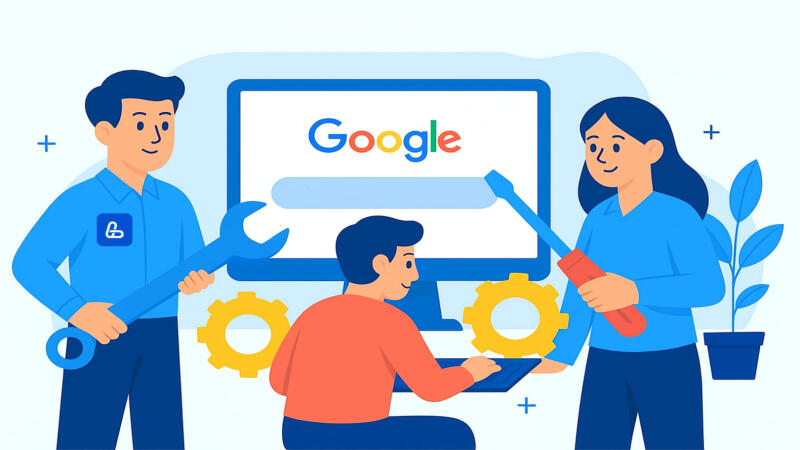Have you ever invested in expensive links, waited for a ranking boost, but saw no results? The reason might be simple – Google hasn’t noticed them. Index backlinks is a critical yet often overlooked step in link building. Without it, even the highest-quality links won’t deliver results.
In this guide, we’ll explore why backlinks aren’t indexed, how to check their status, and most importantly, proven methods to get backlinks indexed quickly in 2025. From Google’s official tools to lesser-known hacks, you’ll gain a complete toolkit to tackle this essential SEO challenge.
What Is Backlink Indexing and Why It Matters in 2025
Backlink indexing refers to the process where Google discovers, crawls, and adds links from other sites pointing to your website into its index. Without indexing, even top-tier backlinks are invisible to search engines and provide no value.
In 2025, understanding how to index backlinks is more critical than ever. Google’s modern algorithms are smarter, evaluating not just the quantity of links but their quality, relevance, and natural appearance. Mastering backlinks indexing processes gives you a competitive edge.
Getting a link is only half the battle. The other half is ensuring it’s indexed and visible to search engines. This requires a systematic approach and knowledge of up-to-date strategies.
How Google Indexes Links: Updated Algorithms in 2025

In 2024-2025, Google rolled out significant updates to its link indexing algorithms with Spam Update and Core Update. The search giant now takes a more selective approach, prioritizing quality and context in backlink indexing.
Key changes in how algorithms work:
- Links from content with high user engagement (e.g., actively read, commented on, or shared) are indexed faster.
- Machine learning enables Google to better assess a link’s value to users, considering:
- Relevance of the donor page’s content to your site
- User signals around the link (clicks, time on page)
- Interaction history between domains
- Natural growth of link mass
- Link index processes in 2025 are more intelligent, evaluating a link’s role in the broader information landscape.
- Search bots are now better at detecting artificial link-building patterns and may ignore suspicious ones.
The algorithm places greater emphasis on the connection between links and user experience, making backlinks indexing more dependent on content quality and behavioral factors.
Why Backlinks Aren’t Indexed: 7 Main Reasons

Many SEO professionals face situations where hard-earned backlinks remain invisible to Google. Understanding the key barriers to backlink index helps you build more effective link-building strategies. The question why are my backlinks not showing up requires analyzing technical, content, and algorithmic factors.
Low Authority of the Donor Site
The authority of the donor site plays a pivotal role in the speed and likelihood of backlinks indexing. Google allocates limited resources to indexing, and low-authority sites often fall low on the priority list.
Metrics like Domain Rating (DR) from Ahrefs or Domain Authority (DA) from Moz help gauge indexing potential. In 2025, sites with DR below 20 are indexed much slower and less comprehensively.
Beyond numerical metrics, the donor’s spam score matters. Sites with a high spam score (above 30% per SpamBrain) are often under algorithmic filters, making index links from them unlikely.
Factors affecting donor trust:
- Domain age (younger domains are less reliable)
- Domain history (past use for spam)
- Topical relevance (niche alignment)
- Content quality and originality
- Technical performance (loading speed, mobile optimization)
For maximum efficiency, prioritize donors with DR above 30, low spam scores, and a stable indexing history. This is especially crucial when aiming to get backlinks indexed quickly for your project.
Lack of Link Equity
Link equity, or the value a link passes, is critical. In 2025, Google pays closer attention to the context and naturalness of link placement. How to get backlinks indexed largely depends on how organically they’re integrated into content.
Key components of link equity:
- Relevant anchor text. Over-optimized anchors with exact-match keywords raise red flags. In 2025, diverse anchors – including branded, topical, and partial keyword matches – are preferred.
- Surrounding text. Links in contextually relevant content are indexed faster. Search engines analyze the text around the link (about 100 characters on each side).
- Topical relevance. The connection between the donor and acceptor site’s themes must be clear to algorithms. Links from irrelevant sites are often ignored.
- Page position. Links in the main content are indexed better than those in sidebars, footers, or headers.
To boost link equity:
- Place links in the main content, ideally in the first third of the text
- Use varied, relevant anchors
- Ensure logical connections between the context and target page
- Avoid clustering multiple external links in one block
With the right approach to link equity, backlinks indexer processes happen faster and more reliably.
Technical Errors
Technical barriers remain a common reason why backlinks aren’t showing up in the index. These issues can completely block indexing, even with high-quality donors and content.
Main technical obstacles:
- Noindex directive in meta tags or HTTP headers tells search engines not to index a page. Links on such pages won’t count, even if discovered.
- Robots.txt blocking prevents bots from visiting a page. If the donor page’s URL is blocked, Google can’t find the links.
- Canonicalization may redirect link equity to another page version. If a page with your link has a canonical tag pointing elsewhere, your link may lose value or not index.
- JavaScript rendering without SEO support complicates link discovery. Links added dynamically via JavaScript may not be seen during initial crawls.
- Rel=“nofollow” attribute signals Google not to pass link equity. While treated as a hint, nofollow links are indexed with lower priority.
- HTTP status errors (404, 500, 503) on the donor page make indexing impossible.
To address technical issues:
- Use tools like Screaming Frog SEO Spider to check donor pages’ technical parameters
- Monitor HTTP statuses of pages with your links
- Verify robots.txt and meta tags before link placement
- Place links in HTML content rather than dynamically generated blocks

Overly Frequent or Unnatural Link Building
The pace of acquiring backlinks is a critical factor for indexing in 2025. Google closely monitors the naturalness of link growth.
Unnatural link-building patterns that hinder indexing:
- Sudden link spikes raise suspicion. If your site typically gains 5-10 links monthly but suddenly acquires 100+ in a week, it looks manipulative. Google may delay indexing or apply filters.
- Uniform links with identical anchors or from similar site types (e.g., only forums or directories) create an unnatural profile. Diversity in sources and link types is key to successful index links.
- Over-optimized anchors with high keyword density appear manipulative. Modern algorithms expect natural distributions, favoring branded and non-anchor links.
- Mass use of automated services leaves digital footprints that algorithms easily detect, often ignoring such links.
To ensure natural link building:
- Create a link acquisition calendar with gradual growth
- Diversify sources across platform types
- Use varied anchors reflecting natural mentions
- Mix dofollow and nofollow links
- Prioritize topical platforms with relevant content
Order comprehensive natural link building at LinkBuilder.com. We offer a full-cycle link-building service, including strategy development, selecting authoritative donors, creating relevant content, and manually placing links. The service suits businesses of all sizes, digital marketing agencies, and SEO specialists aiming for safe, effective promotion.
What’s included in our comprehensive link-building service:
- Analysis and Strategy Development
- In-depth competitor analysis, their link profiles, and content strategies
- Identifying growth opportunities and setting link-building goals based on your niche and brand
- Developing a personalized strategy tailored to search engine algorithm updates
- Selection of Authoritative Donors
- Access to a database of over 300,000 media sites across 150+ regions and languages
- Careful selection of platforms with high Domain Rating (DR), Trust Rank (TR), and quality metrics for natural, relevant links
- Use of only trusted, authoritative sources matching your niche
- Content Creation and Placement
- Producing high-quality, SEO-optimized content, including guest posts, tailored to region and language
- Manual link placement to ensure natural perception by search engines
- Optimizing anchor text and target pages for maximum effectiveness
- Quality Control and Analytics
- Internal moderation and quality checks for links
- Regular analysis of link impact on traffic, search rankings (SERP), and conversions
- Transparent reporting with recommendations for further promotion
- Additional Features
- 24/7 support and free consultations before starting
- Scalable strategies based on business needs
- Building long-term partnerships with sites in your niche for growth opportunities
LinkBuilder.com focuses on safe and natural link building to minimize the risk of search engine penalties. Each link is placed manually, ensuring seamless integration into content and compliance with algorithm requirements.
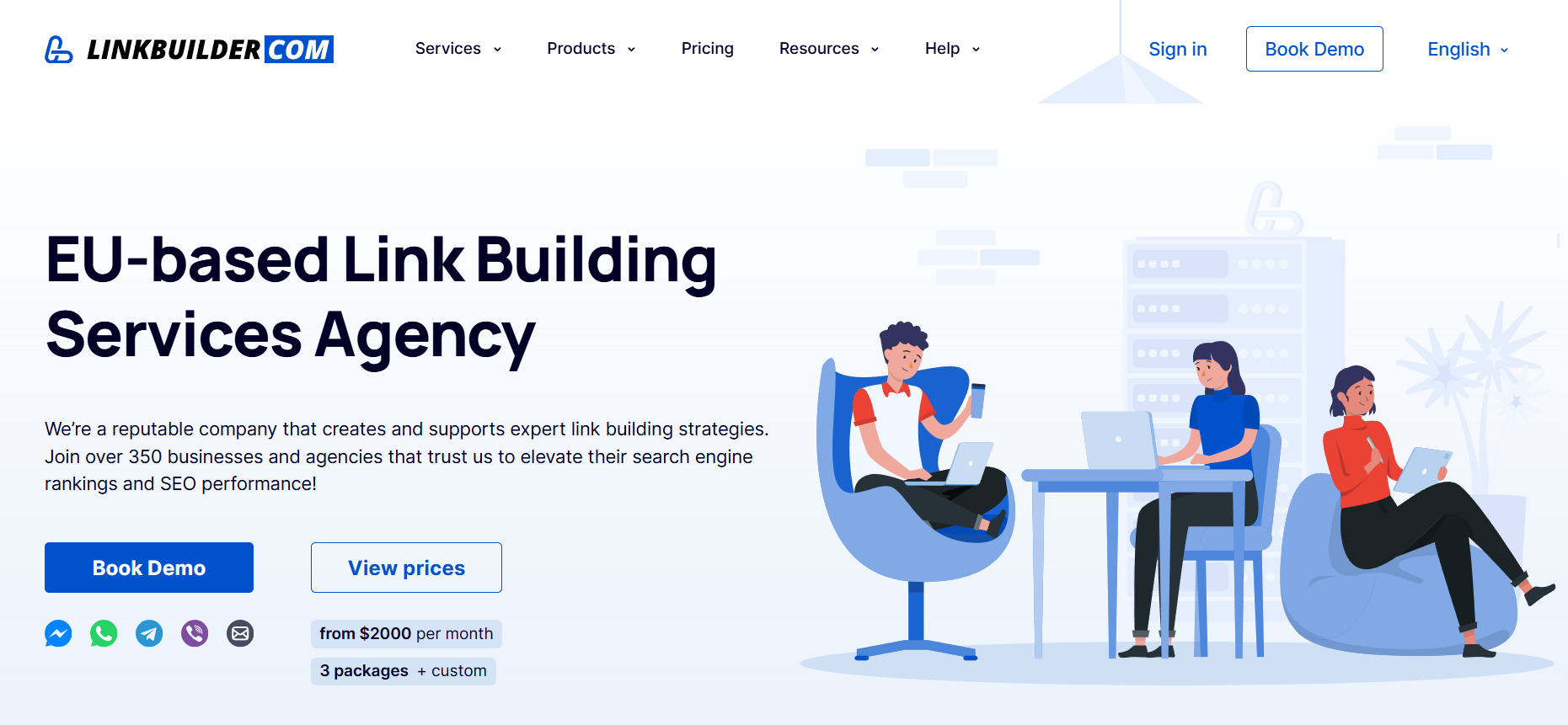
Schedule a meeting to scale your business safely and effectively!
Issues with the Source Site
The condition of the donor page is critical for backlink indexing. Even if a link was initially indexed, changes on the donor site can lead to its removal from the index. This is a common reason why backlinks aren’t showing up.
Common issues with donor sites:
- Page or content deletion results in the loss of all links on that page. This is common for temporary content like news or event announcements that may be archived or removed.
- 404 (Not Found) errors occur when a page no longer exists. Google quickly removes such pages from its index, along with their links.
- Server errors (5xx) indicate technical issues on the donor’s side. Prolonged inaccessibility can lead to deindexing.
- Redirects (301, 302) shift users and bots to other URLs, potentially losing link equity or rendering links irrelevant if redirected to unrelated pages.
- URL structure changes without proper redirects create broken links.
- Domain ownership changes may alter the site’s content or purpose, making links irrelevant or harmful.
To minimize risks:
- Regularly monitor the status of pages hosting your valuable links
- Use tools like Ahrefs or Semrush to track lost links
- Diversify your link profile to avoid reliance on a few donors
- Prioritize stable sites with a long history
- Contact site owners promptly to restore lost links
Google Doesn’t Consider the Link Valuable
In 2025, Google places greater emphasis on user signals when evaluating link value. Links may not index if the algorithm deems them irrelevant to users.
Factors reducing a link’s value:
- No clicks on the link signal low user value. Google tracks click-through rates (CTR) and prioritizes links with actual user engagement.
- Low traffic on the donor page means even valuable links get little attention. Google focuses on content viewed by real users.
- Irrelevant placement reduces user interaction. Links that seem out of place or overtly promotional receive fewer clicks and index poorly.
- Poor metrics on the acceptor site, like high bounce rates, can lower a link’s value if visitors leave quickly after clicking.
- Link age without engagement matters. New links get a “trust credit,” but without user activity over time, their value drops.
To increase link value:
- Place links on pages with active audiences and real traffic
- Use compelling, informative anchors to encourage clicks
- Ensure relevance between donor content and your target page
- Optimize target pages to retain visitors
- Use UTM tags to track performance from different sources
The speed of backlinks indexing depends not only on technical factors but also on the real value links provide to users.
Penalties or Manual Actions
Algorithmic and manual penalties can severely hinder the indexing of new links. In 2025, how to get backlinks indexed under penalties is tougher due to improved violation detection systems.
Algorithmic penalties are applied automatically upon detecting violations. Common algorithms affecting indexing in 2025:
- Helpful Content Update: Targets low-quality content
- SpamBrain: Detects spam tactics
- Link Spam Update: Identifies unnatural link schemes
Manual Actions are imposed by Google’s team after human review, with notifications sent via Search Console detailing the issue and fixes.
Common reasons for penalties:
- Unnatural inbound or outbound links
- Participation in link exchange schemes
- Buying links that pass PageRank
- Over-optimized anchor text
- Using automated link-building systems
Signs of penalties:
- Sharp drop in new link indexing speed
- Disappearance of previously indexed links
- Manual action notifications in Search Console
- Significant drop in site visibility in search results
Solutions to restore normal indexing:
- For algorithmic penalties:
- Analyze your link profile using tools like Ahrefs or Semrush
- Disavow low-quality or spammy links via Google’s Disavow Tool
- Fix content and technical site issues
- Plan gradual acquisition of high-quality, natural links
- For Manual Actions:
- Review the Search Console notification carefully
- Address all issues (remove spammy links, fix content)
- Prepare a detailed report of actions taken
- Submit a reconsideration request via Search Console
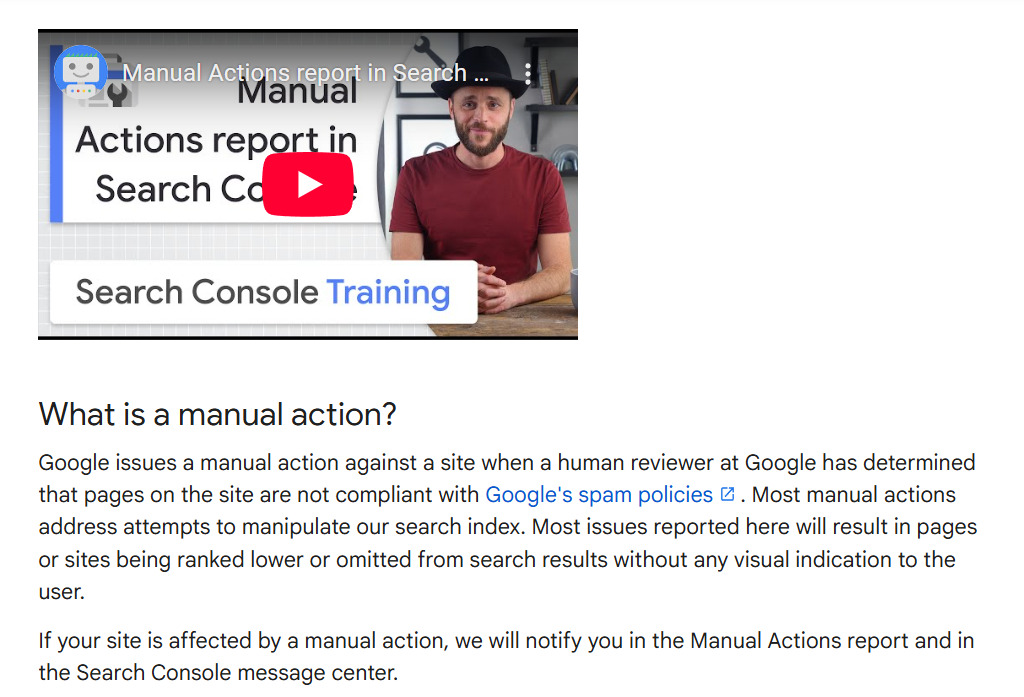
Recovery from penalties takes time and consistency. After addressing issues, normal indexing may resume in weeks to months.
7 Proven Strategies for Fast Backlink Indexing in 2025

In 2025, how to get backlinks fast and indexed requires a multifaceted strategy that accounts for Google’s algorithm updates and user behavior. Here are seven proven methods to index links quickly.
1. Using Google Search Console for Manual Submission
Google Search Console (GSC) remains the simplest official method for backlink indexer tasks.
How to submit a URL manually:
- Log into Google Search Console and select your site
- Go to the “URL Inspection” tool at the top
- Enter the full URL of the page with your backlink
- Click “Request Indexing”
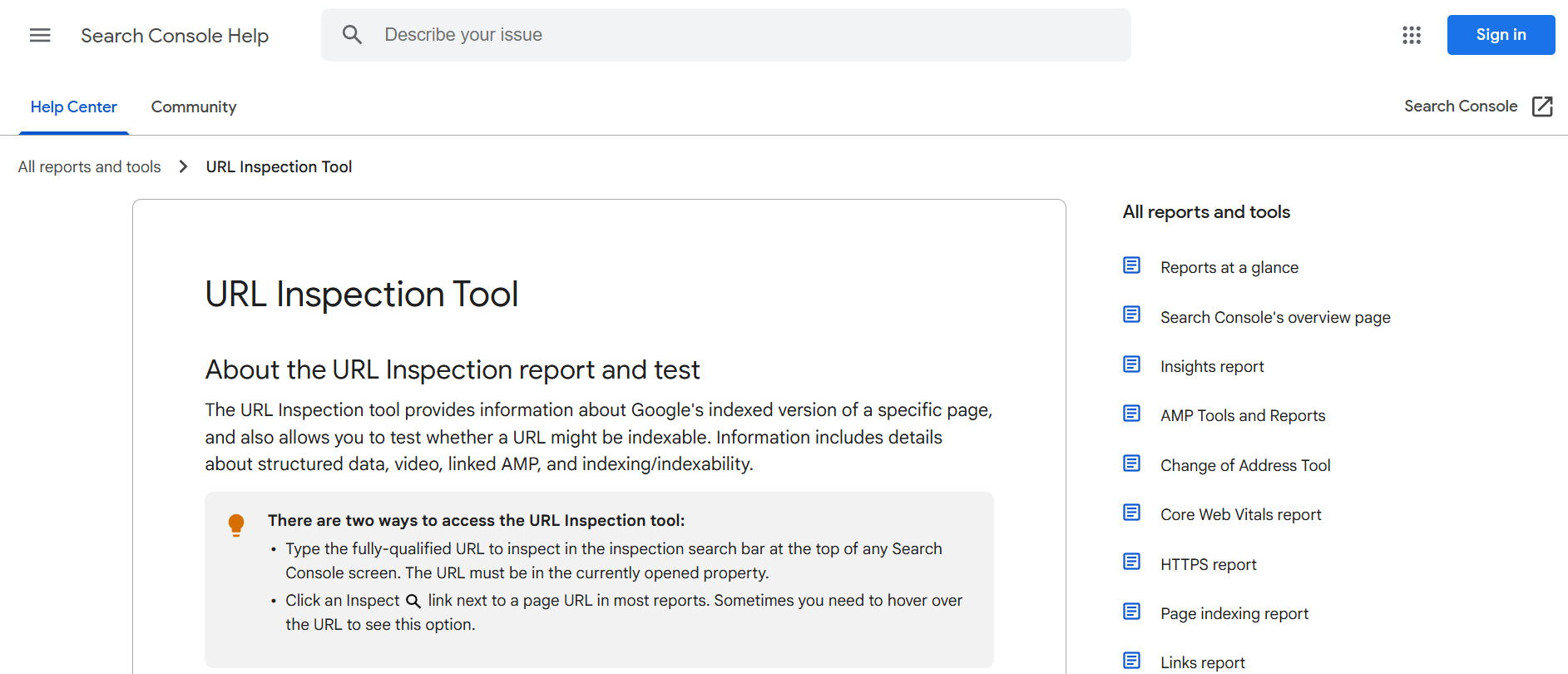
This method works for a small number of priority links.
Bulk URL submission:
- Prepare a CSV file with URLs for indexing
- Use the Search Console API to submit requests (requires basic coding skills or specialized tools)
- Track indexing status via the “Coverage” report in GSC
Note: Google limits API submissions to 200 URLs per day per domain.
Alternatives to GSC
Beyond Google’s tool, other solutions complement backlink indexing efforts:
- Bing Webmaster Tools offers similar functionality for indexing in Bing, which is increasingly relevant in 2025 due to Bing’s growing market share.
- IndexNow is a protocol supported by Bing, Yandex, and others, enabling quick notifications of new or updated URLs. It gained popularity in 2025 for its ease of use.
- CMS plugins automate URL submissions upon content publication or updates. For WordPress, plugins like Rank Math and Yoast SEO integrate IndexNow support.
Submitting URLs via GSC or alternatives doesn’t guarantee indexing – it’s a request for crawling. Google’s algorithms decide based on content quality and other factors.
2. Social Signals and Sharing on Social Media
Social signals are a highly effective way to get backlinks indexed in 2025. Search bots actively monitor popular social platforms, and sharing links there can significantly speed up discovery and backlinks indexing.
Top platforms for impact
Reddit remains a powerful tool for accelerating indexing. Tips for 2025:
- Post in active, relevant subreddits for maximum effect
- Accounts with positive karma and history get priority from bots
- Content with organic upvotes indexes within hours
LinkBuilder.com offers a Reddit link placement service, including:
- Posting your content in relevant, active subreddits
- Adding natural comments with your links from established accounts
- Monitoring and reporting on indexing status
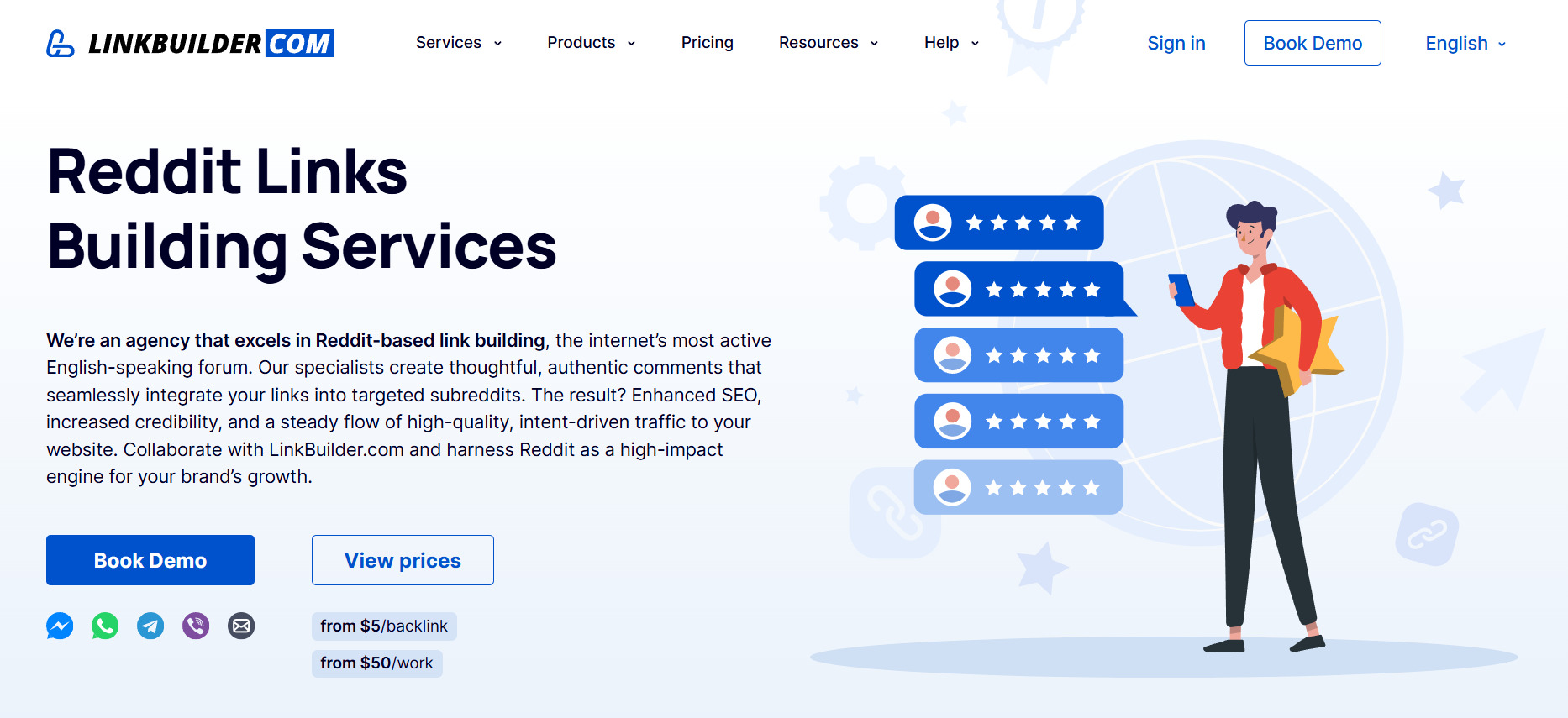
Contact us to place links on Reddit and index backlinks quickly.
Twitter (X) remains one of the fastest-indexed platforms in 2025:
- Relevant hashtags boost visibility and indexing speed
- Retweets and likes from authoritative accounts accelerate the process
LinkedIn excels for B2B niches:
- Posts in professional groups are indexed with priority
- High-engagement content (comments, reactions) speeds up indexing
- LinkedIn Pulse articles index faster than regular posts
Other effective platforms in 2025:
- Pinterest: Ideal for visual niches
- Quora: Great for educational and expert content
- Medium: Suitable for in-depth, analytical content
- Discord: Effective for tech and gaming niches
Tips for using social media for indexing:
- Vary posting times for naturalness
- Use diverse content formats (text, images, videos)
- Add value, don’t just share links
- Engage with comments to boost interaction
Combining social media with other methods can significantly accelerate backlinks indexer efforts and enhance backlink effectiveness.
3. Archiving via Web Archives
Web archives offer an unconventional but effective way to speed up backlink indexing.
How archiving accelerates indexing
The mechanism works as follows:
- Alternative discovery source. Search bots regularly crawl archives for new content. Archiving a page creates an additional entry point for search engines.
- Value signal. Google views archiving as a sign of a page’s importance, potentially prioritizing its indexing.
- Structured metadata. Archives provide metadata that helps search engines understand page content and context.
- Bypassing temporary issues. If a donor site is temporarily unavailable, search engines can still find your link via the archived copy.
Services for automatic archiving
Wayback Machine (Internet Archive) is the largest and most influential web archive:
- Visit web.archive.org
- Enter the URL of the page with your link
- Click “Save this URL”
- Ensure the “Save outlinks” option is enabled to archive linked pages
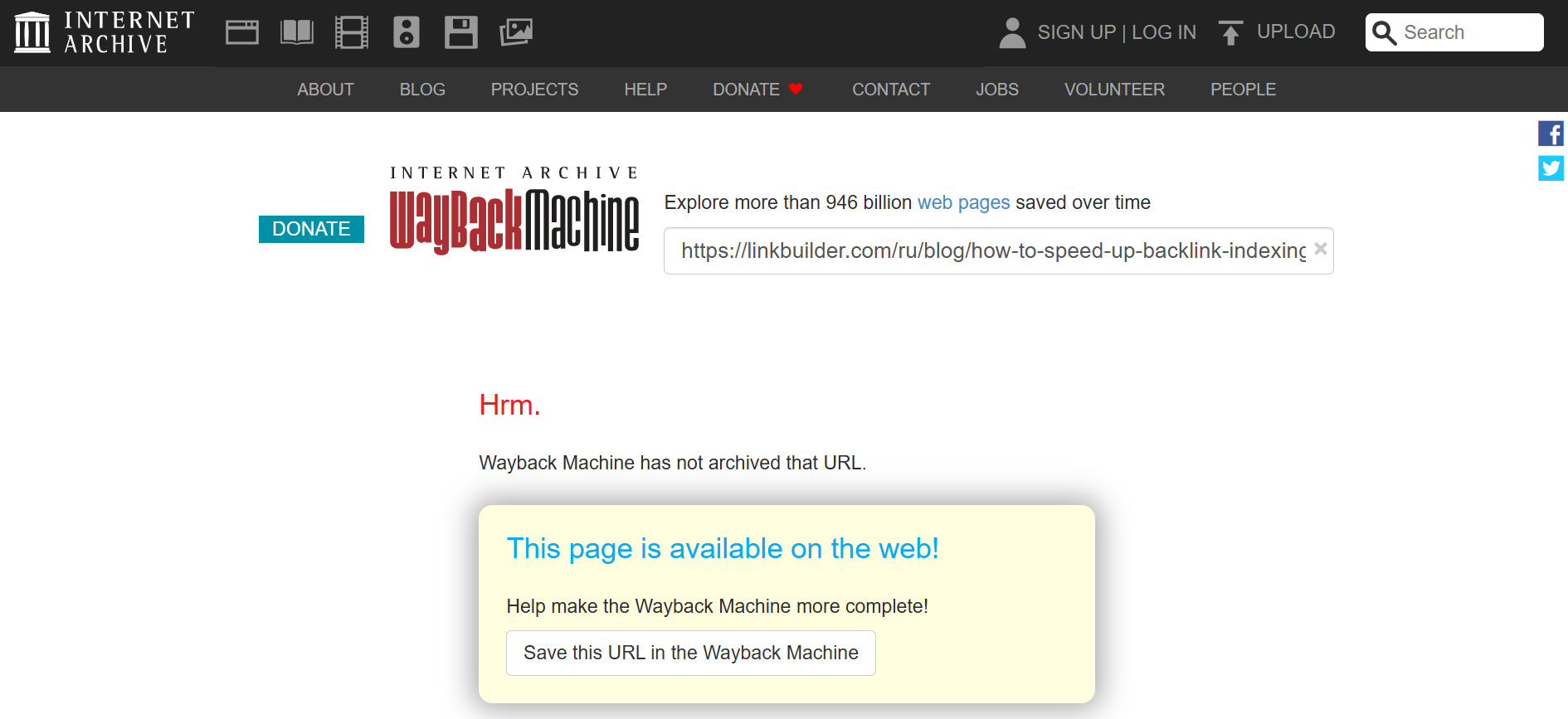
Archive.today is an alternative archiving service:
- Go to archive.ph
- Enter the URL in the “Archive a page that is currently online” field
- Wait for the archiving process to complete
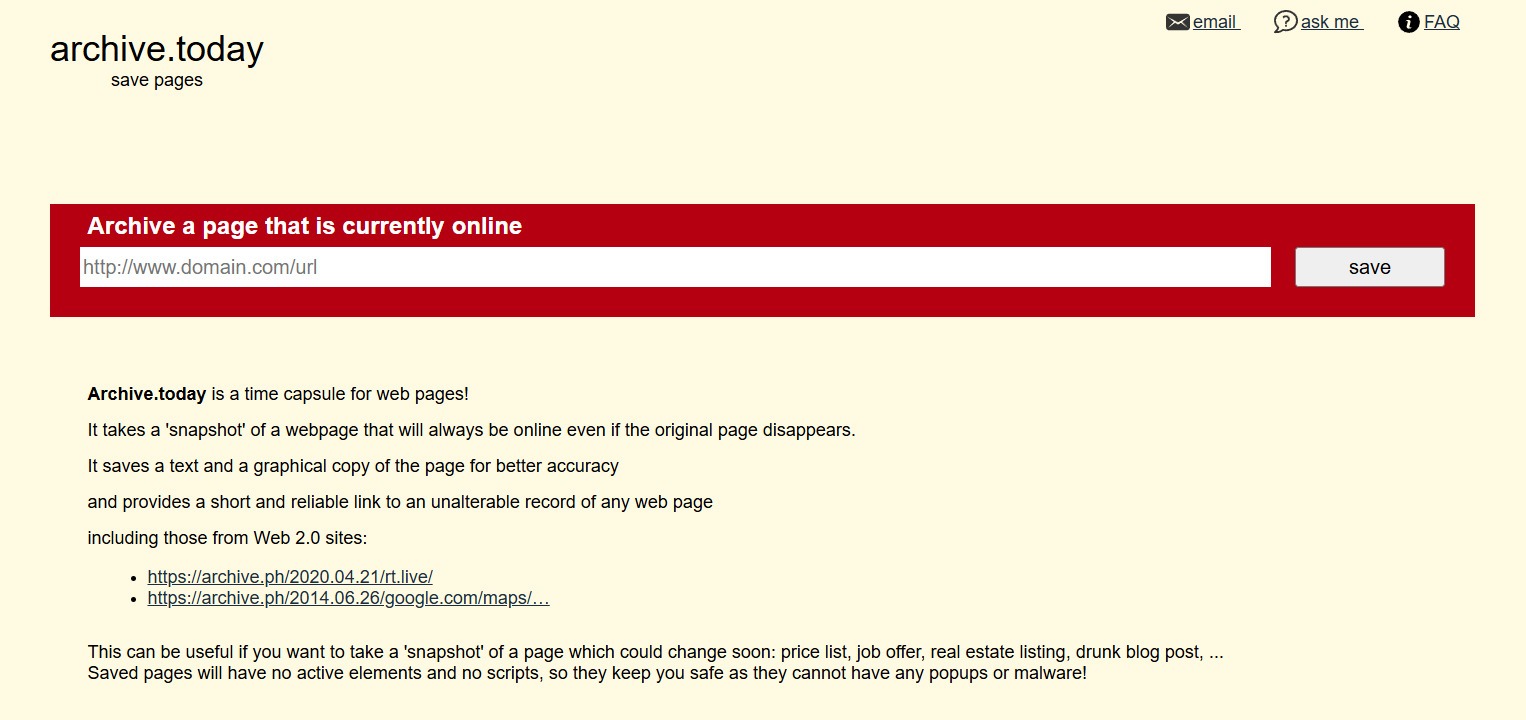
Tools for automated archiving:
- ArchiveBox: A self-hosted solution for archiving lists of URLs
- Waybackpy: A Python library for programmatic interaction with Wayback Machine
- IFTTT and Zapier: Offer integrations for automatic archiving based on events (e.g., new post publication)
- Browser extensions: Wayback Machine Browser Extension and Archive Page allow one-click archiving
For maximum effectiveness:
- Archive both the page with your link and the target page
- Use multiple archive services for key links
- Schedule regular archiving for pages with frequently updated content
- Verify successful archiving, especially for dynamic content
This strategy is particularly useful for indexing links from new or low-traffic sites that search bots visit infrequently.
4. Acceleration via Ping Services and RSS Aggregators
Ping services and RSS aggregators remain a traditional but effective way to use a backlink indexing tool to speed up indexing.
Ping tools:
PingOMatic: A free service that notifies search engines and content aggregators about new blog or site posts to accelerate indexing. To use:
- Visit pingomatic.com
- Enter your blog/site name and URL
- Select services to ping
- Click “Send Pings”
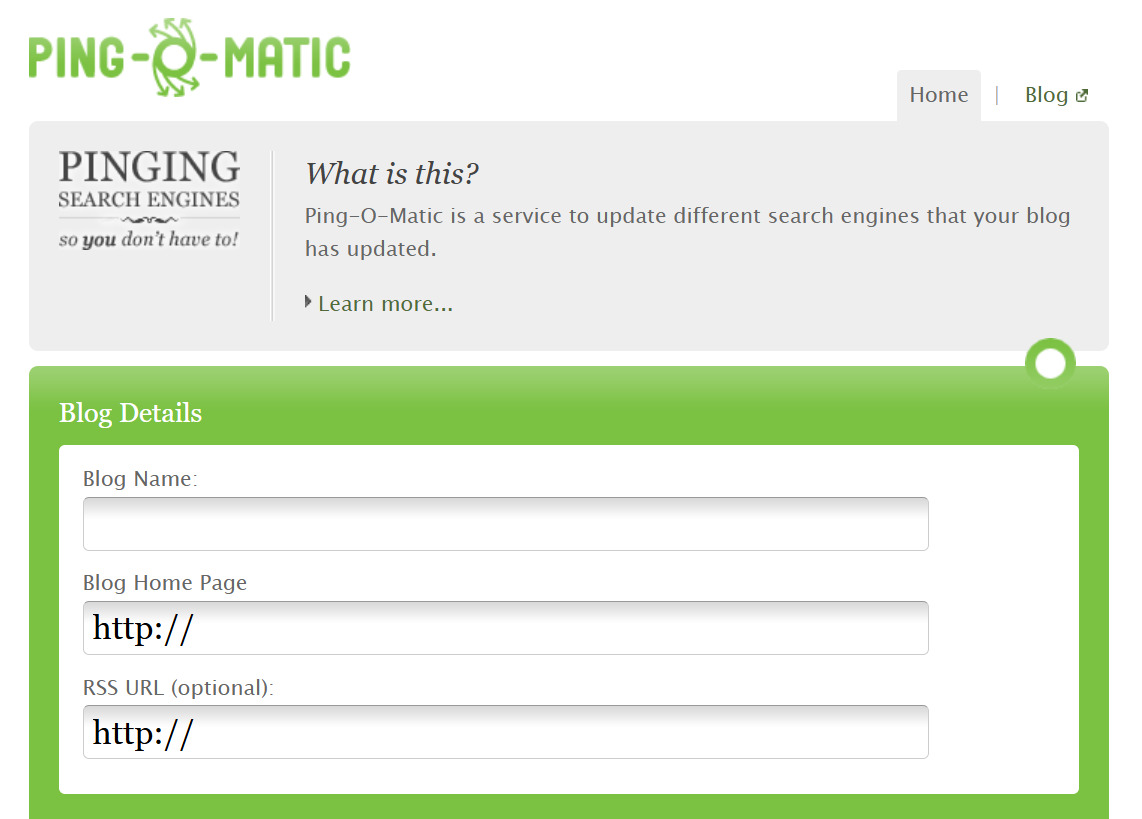
Google Blog Search Ping: A specialized tool for notifying Google about new content. Features:
- Direct integration with Google’s infrastructure
- High priority for blogs with regular updates
- XML-RPC support for automation
Bing Webmaster Tools Ping: Microsoft’s equivalent service:
- Notifies Bing about new content
- Integrates with IndexNow protocol
- Provides detailed crawl statistics
Blogsearch Ping Service: An aggregator that pings multiple services simultaneously:
- Covers over 80 search engines and aggregators
- Prioritizes services intelligently
- Analyzes channel effectiveness
Creating an RSS feed for new links
RSS feeds remain an effective way to signal search engines about new content. For fast backlink indexing, create a dedicated RSS feed for your link profile updates.
For donor site owners:
- Create a separate RSS feed for pages with external links:
- For WordPress, use plugins like Feedzy RSS Feeds or WP RSS Aggregator
- For other CMS, use specialized modules or RSS generators
- Set up automatic feed updates when new content with links is added
- Register the feed in popular RSS directories:
- Feedly
- Inoreader
- NewsBlur
- The Old Reader
- Add the RSS feed link to your site’s navigation and <head> tag
For SEO specialists without donor site access:
- Create an aggregating RSS feed using services like Feedity or Feed43 to generate feeds from any webpage
- Monitor pages with your backlinks and auto-add them to the feed
- Use IFTTT or Zapier for automated workflows:
- New link detected → Add to RSS feed → Ping aggregators
- Share the aggregating feed via social media and RSS directories
Combining ping services with well-configured RSS feeds creates a steady stream of signals to search engines, significantly speeding up backlinks indexing even for low-traffic sites.
5. Internal Linking and “Link Pushers”
Internal linking involves creating links within your site that guide users to related content, such as an article on How to Speed Up Backlink Indexing in 2025. This improves user navigation and site structure for search engines.
The “link pusher” strategy is one of the most effective ways to accelerate backlinks indexing in 2025. It leverages the authority of already indexed pages to “push” new links into the search engine index.
Placing links on indexed pages
The strategy creates “bridges” between indexed content and new pages with your backlinks.
How “link pushers” work:
- Select high-authority, frequently crawled donor pages:
- Homepage (often crawled daily)
- News or blog pages with regular updates
- Popular categories or sections with high traffic
- Pages with high PageRank and authority
- Update these pages with mentions and links to pages containing your backlinks:
- Add references to new resources in existing articles
- Create lists of recommended materials
- Update old content with new links
- Ensure topical relevance – links must fit naturally into the donor page’s context
- Use varied, relevant anchor text
Example implementation:
If you have a backlink on example.com/new-article that isn’t indexed, find an indexed page on the same domain (e.g., example.com/popular-guide) and update it with a mention and link to /new-article. When a search bot visits /popular-guide, it follows the link to /new-article and discovers your backlink.
Using satellites and PBNs
Satellites and Private Blog Networks (PBNs) remain potentially effective for fast backlink indexing, but risks have increased in 2025.
Risks of PBNs:
- SpamBrain is more effective at detecting artificial link networks
- Manual penalties for manipulative practices are more common
- Possible full deindexing if PBN connections are detected
- High cost of maintaining quality PBNs (domains, hosting, content)
To use PBNs safely, order PBN network creation from LinkBuilder.com. Professional PBN setup minimizes errors and penalties.
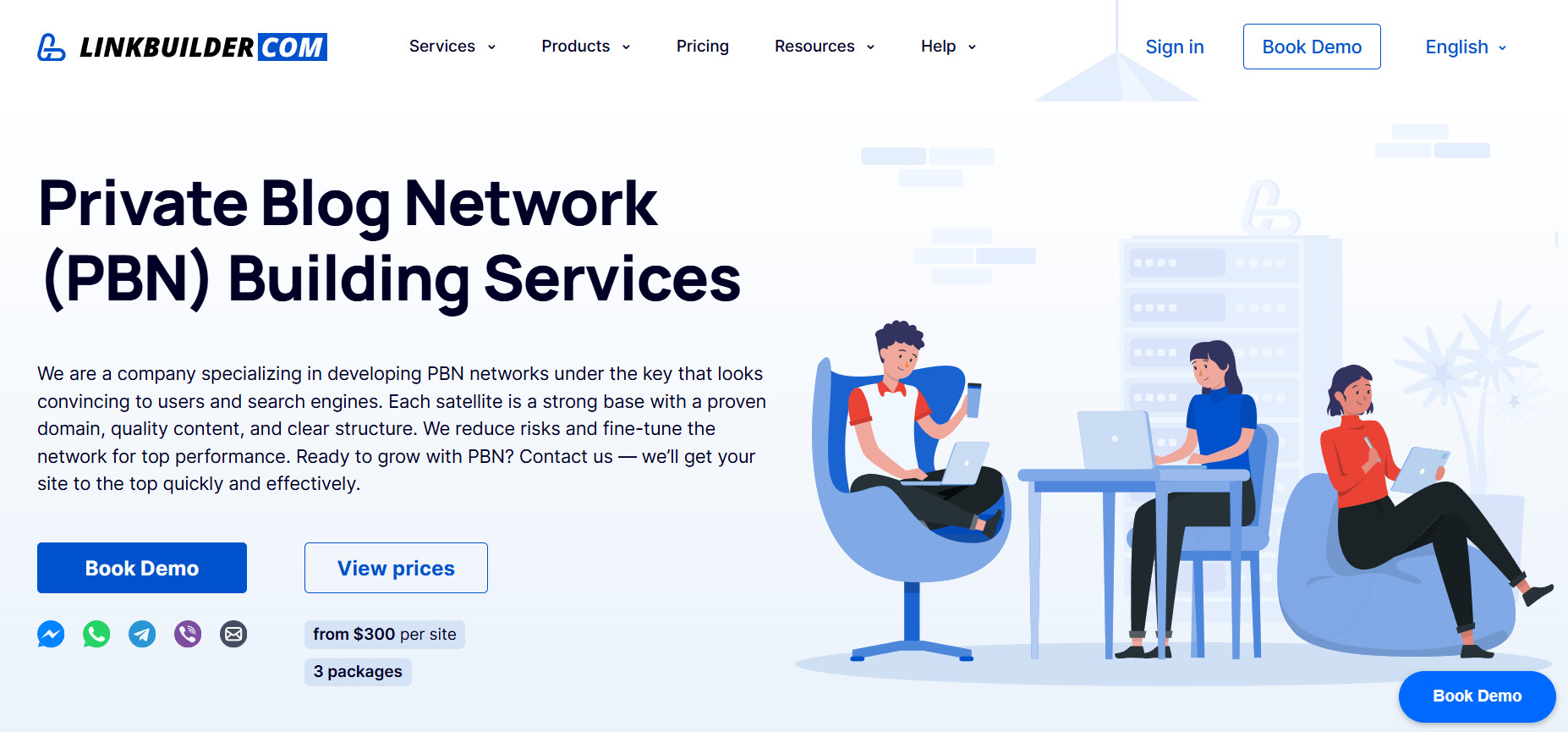
6. Guest Posting and Media Mentions
Guest posting and media mentions remain top “white-hat” methods for fast backlink indexing. In 2025, these strategies have evolved with new nuances.
How to secure dofollow links from high-indexing sites:
- Choose the right platforms:
- Prioritize sites with DR > 50 and low spam scores
- Check indexing frequency – how quickly new posts are indexed
- Review link policies (some sites default to nofollow)
- Analyze traffic and engagement metrics (comments, social shares)
- Create valuable content:
- Develop unique, data-driven materials
- Offer expert insights or original research
- Tailor style and format to the platform
- Include visuals (infographics, charts, tables)
- Place links strategically:
- Integrate links naturally into content
- Ensure topical relevance to the article
- Use diverse anchors, avoiding over-optimization
- Limit links (1-2 per 1,000 words)
- Build relationships with editors:
- Study the outlet’s past publications and style
- Personalize pitches for each platform
- Offer exclusive content or first-publication rights
- Maintain long-term connections via social media
- Prove expertise:
- Build a portfolio of your publications
- Get verified on social platforms
- Participate in industry events and conferences
- Showcase real results and case studies
If you don’t want to handle platform selection or editor outreach, order guest posting from our agency.
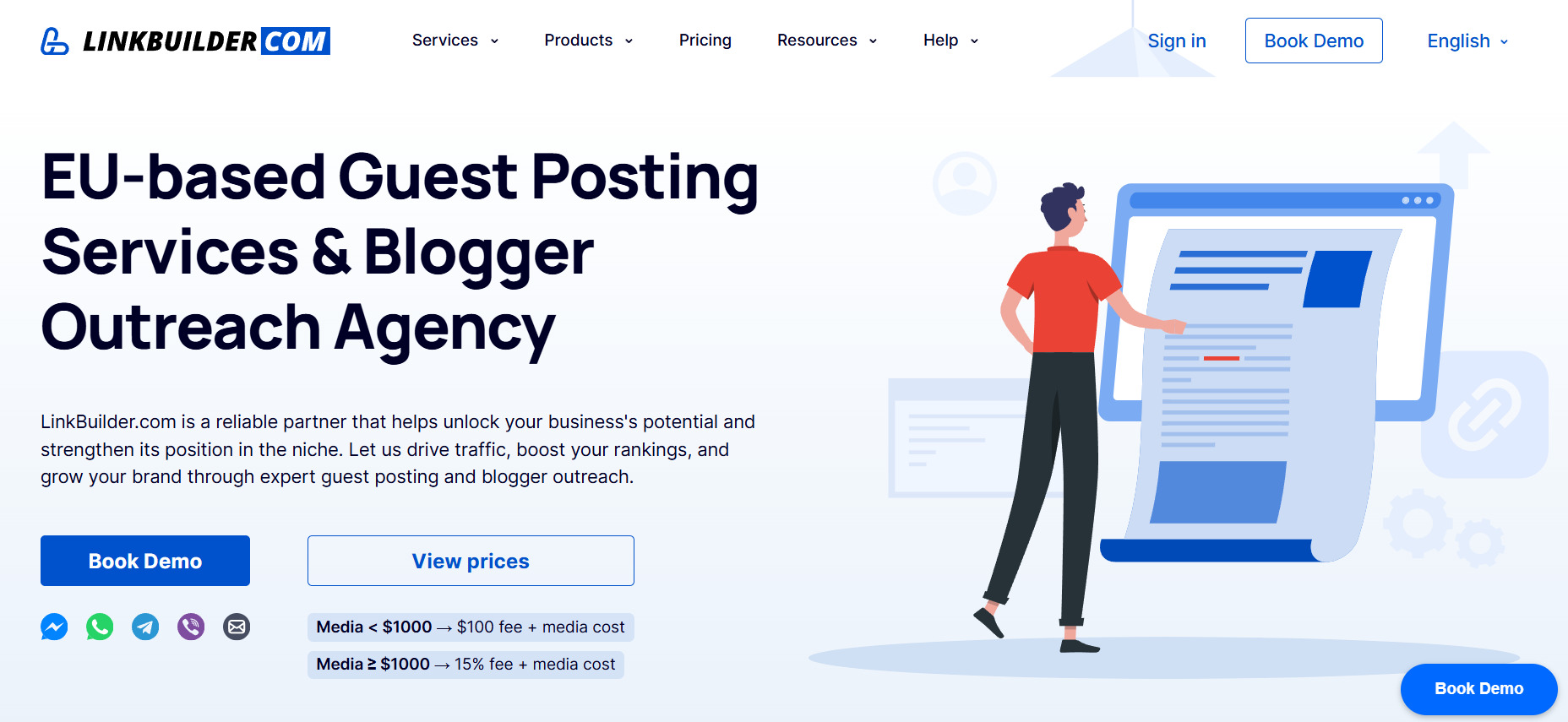
LinkBuilder.com offers comprehensive guest posting services, including:
- Selecting relevant platforms with high DR and guaranteed indexing
- Creating high-quality content by our writers
- Strategic link placement for maximum impact
- Monitoring indexing and reporting results
You can also use our free tools: Guest Post Scanner and Guest Post Website Audit to find vendors and pricing.
Other platforms for placement
Specialized platforms streamline securing quality backlinks from authoritative sources:
HARO (Help A Reporter Out) connects journalists with experts. To participate:
- Register as a source on haro.com
- Select relevant categories and receive daily queries
- Respond quickly with insightful comments
- Published comments often include a link to your site
You can also order HARO links through our agency for professional promotion.
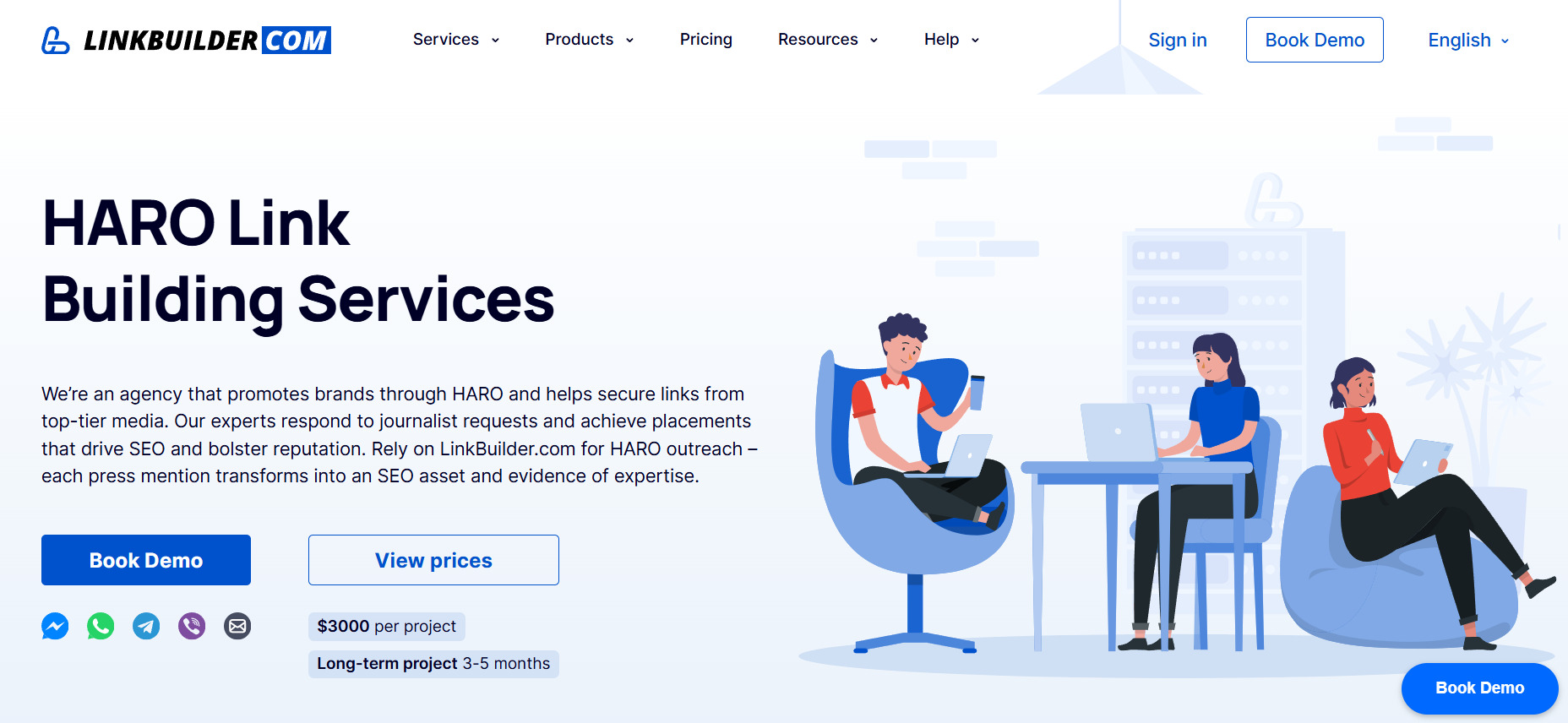
BloggerOutreach.io provides access to a network of vetted bloggers and publishers:
- Filter platforms by DR, traffic, and niche
- Transparent pricing for placements
- Indexing and publication timeline guarantees
- Performance and metrics reports
Other effective platforms:
- Pitchbox: Automates outreach campaigns
- Muck Rack: Focuses on journalist connections
- BuzzStream: Manages publisher relationships
- Respona: Uses AI to find relevant contacts
In 2025, quality trumps quantity. One placement in an authoritative outlet is more valuable for backlinks indexing than dozens on low-quality sites.
7. Safe Indexing Acceleration via LinkBuilder.com
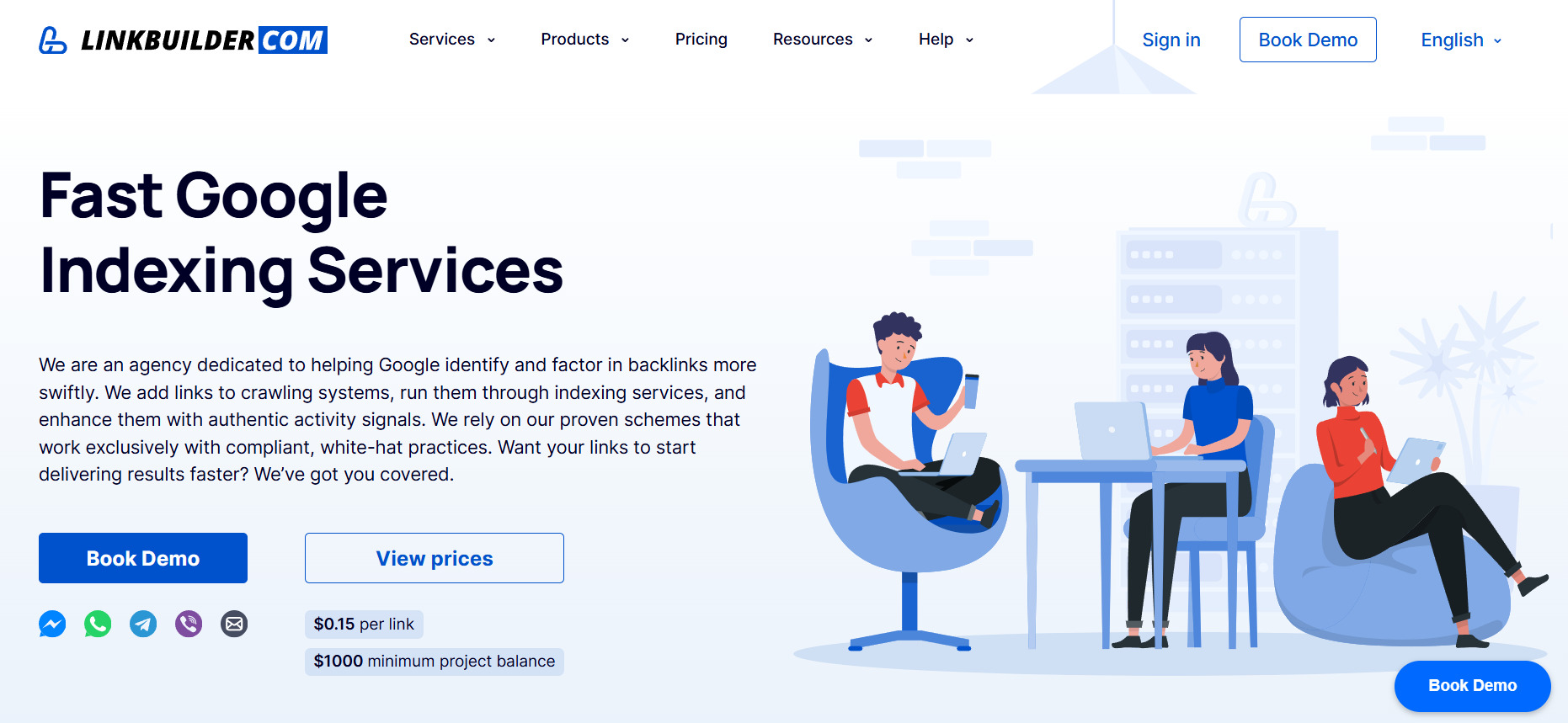
LinkBuilder.com offers a professional accelerated backlink indexing service for Google and other search engines. This is ideal for SEO specialists and site owners who need links to impact rankings quickly. The service uses safe methods, avoiding “gray” tools, and ensures natural indexing.
Key features:
- Indexing takes 24-72 hours, depending on link volume and quality, using priority channels like APIs and manual pings.
- Safe methods comply with Google’s guidelines, avoiding automated runs or spam tactics.
- Works with various link types: guest posts, crowd links, profile mentions, and contextual insertions.
- Detailed reports on each link’s indexing status.
LinkBuilder.com’s backlink indexer tool offers a balance of speed and safety, making it ideal for projects needing predictable results with minimal risks.
7 Tools for Backlink Indexing in 2025
Google Indexing API
The Google Indexing API is an official tool for submitting URLs for indexing. Though designed for temporary content (e.g., job postings, live streams), many SEO professionals use it to accelerate backlink indexing.
Setup requirements:
- Create a project in Google Cloud Console
- Enable the Indexing API
- Generate credentials (JSON key)
- Configure access permissions
- Write code to send requests

Limitations:
- Officially for temporary content only
- 200 URL daily limit per project
- Requires site verification in Google Search Console
- Needs basic coding skills
Despite limitations, it’s a reliable way to get backlinks indexed faster via Google’s official channel.
Bulk Submission Services
When you need to index backlinks in large volumes, specialized services become indispensable helpers.
An example of such a service is Indexification. It uses a multi-tiered strategy for fast link indexing.
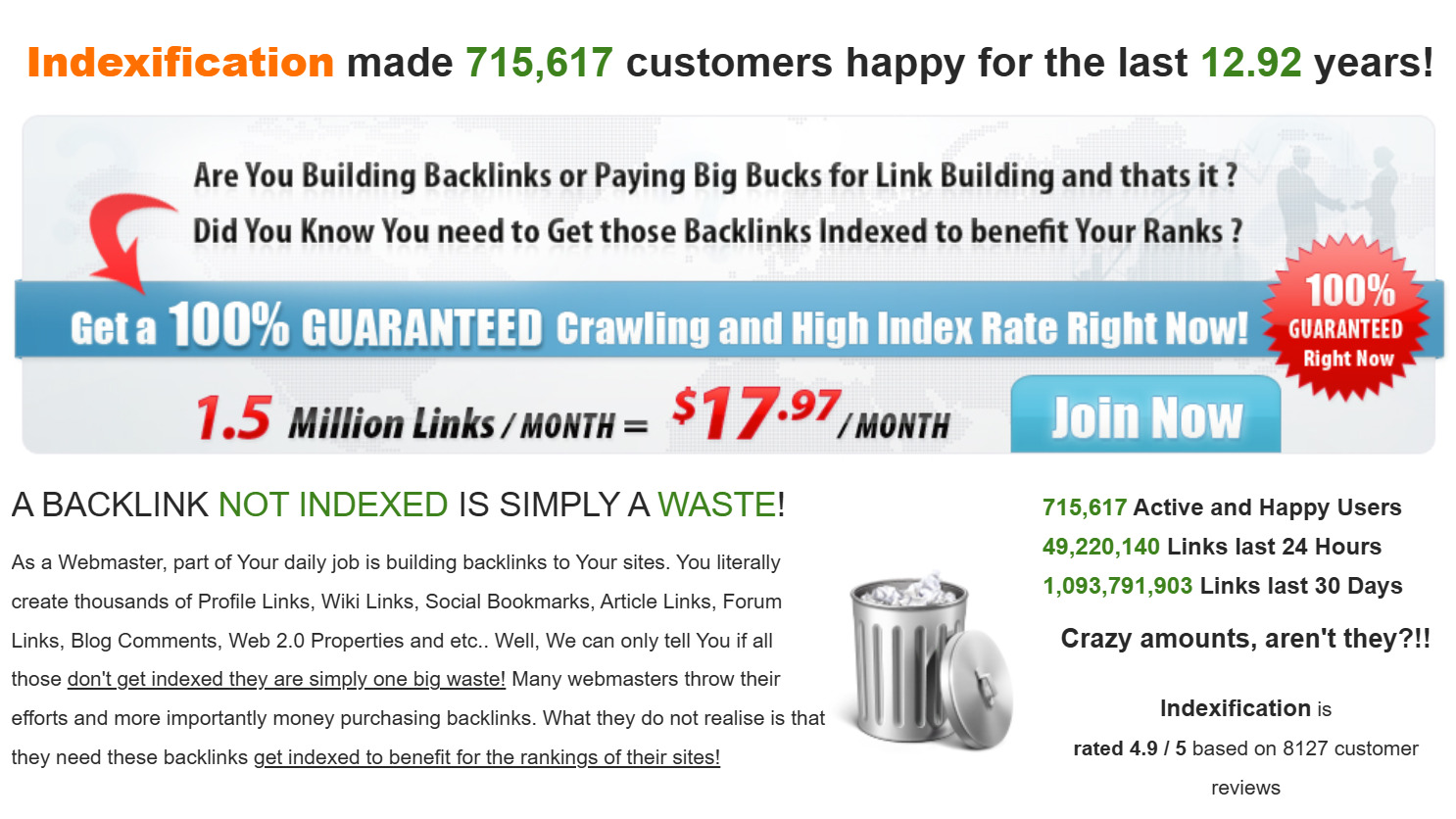
Features:
- Automatic system for sending signals to Google
- Creation of secondary second-tier links
- Real-time progress monitoring
- Different pricing tiers depending on the workload
The service simplifies the process if you need to ensure fast link indexing for a large number of URLs. However, there is a drawback – Google might consider this method spam, so it's important to understand the risks involved.
Automation Scripts
For tech-savvy specialists, scripts offer an efficient way to accelerate backlinks indexing.
Python + Google Search Console API
This combination enables scripts for:
- Automated URL submission for indexing
- Indexing status monitoring
- Report generation
Example submission code:

Indexing Monitoring
Monitoring is critical for assessing backlink indexing strategies. Tools include:
Ahrefs: A market leader for checking backlink indexing. Features:
- Site Explorer for link profile analysis
- “New” feature to identify recently discovered links
- Indexing status filters
- Regular database updates
SE Ranking: A versatile platform with monitoring tools. Key features:
- “Backlink Checker” module with indexing statuses
- Alerts for new or lost links
- Detailed backlink quality insights
- Link profile change reports
JetOctopus: A technical SEO tool for indexing analysis. Features:
- Advanced log analyzer for Googlebot visits
- Real-time monitoring
- Google Search Console integration
- Problem detection alerts
Regular monitoring helps identify issues early and refine backlinks indexing strategies.
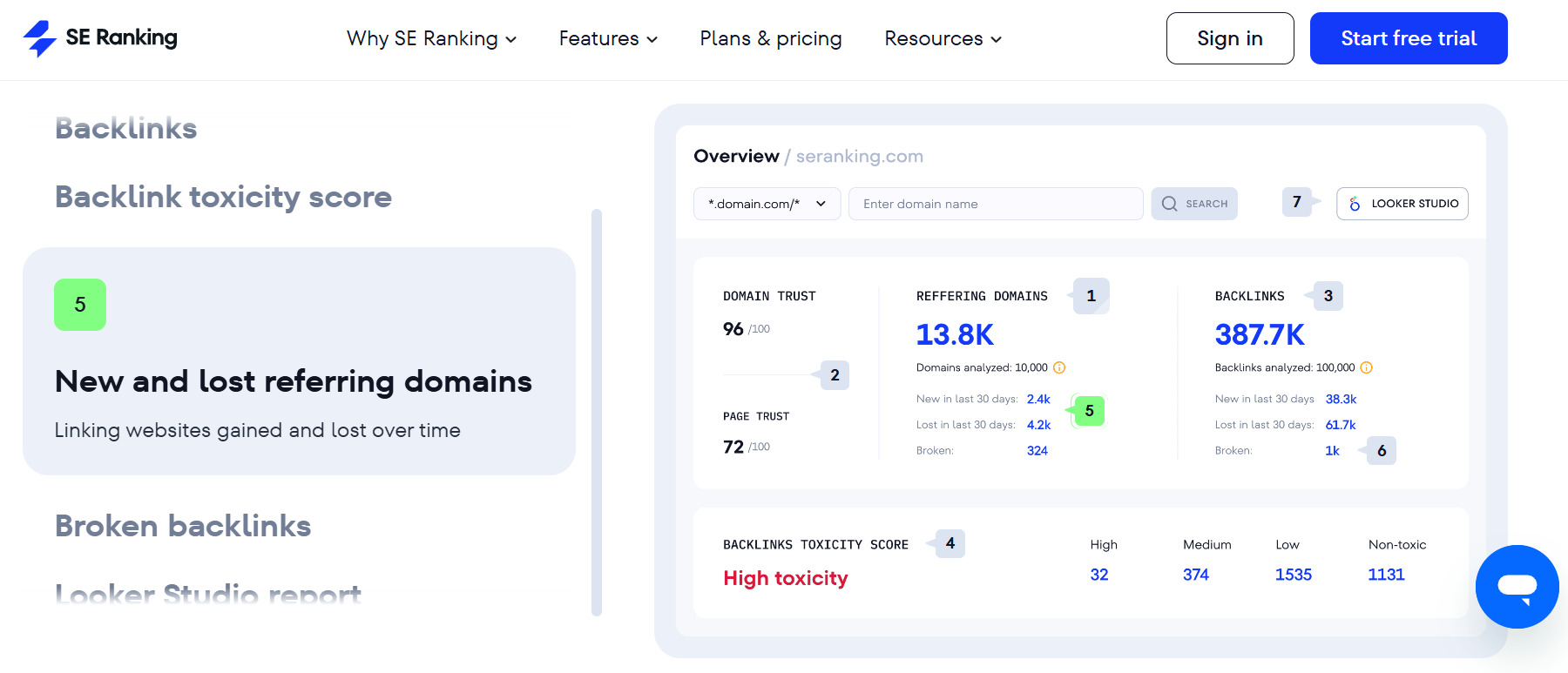
WordPress Plugins
For WordPress sites, there are special plugins that simplify the indexing process. One of them is Instant Indexing by RankMath.
Instant Indexing – a plugin created specifically for submitting URLs to Google and Bing. Functionality:
- Auto-submits new/updated pages
- Supports Google Indexing API and Bing IndexNow
- Manual submission for specific URLs
- Tracks submission success

Advantages of WordPress plugins:
- Easy setup without technical expertise
- Automates indexing for new content
- Integrates with other SEO features
- Regular updates
Alternative Search Engines
While Google is the priority, alternative search engines can help index backlinks. Microsoft Bing offers the IndexNow protocol for instantly notifying search engines about changes.
Advantages:
- Simple API integration
- Supported by Bing, Yandex, and others
- Fast indexing (often within minutes)
- No strict submission limits
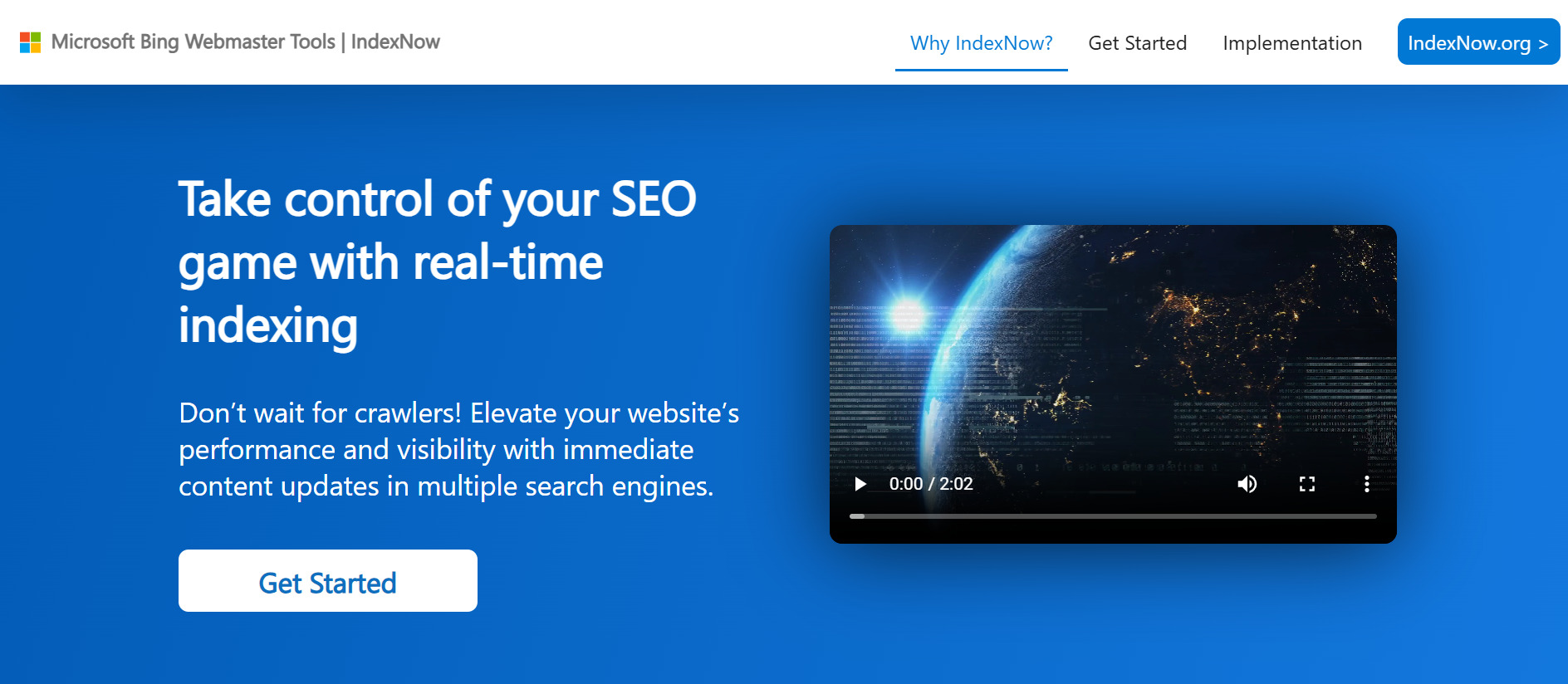
How alternative search engines help with Google:
- Increase link visibility online
- Boost chances of Google discovering links
- Drive additional traffic to attract Google’s attention
- Diversify visitor sources
This approach is gaining traction among backlink indexing tools in 2025.
LinkBuilder.com – Comprehensive Indexing Solution
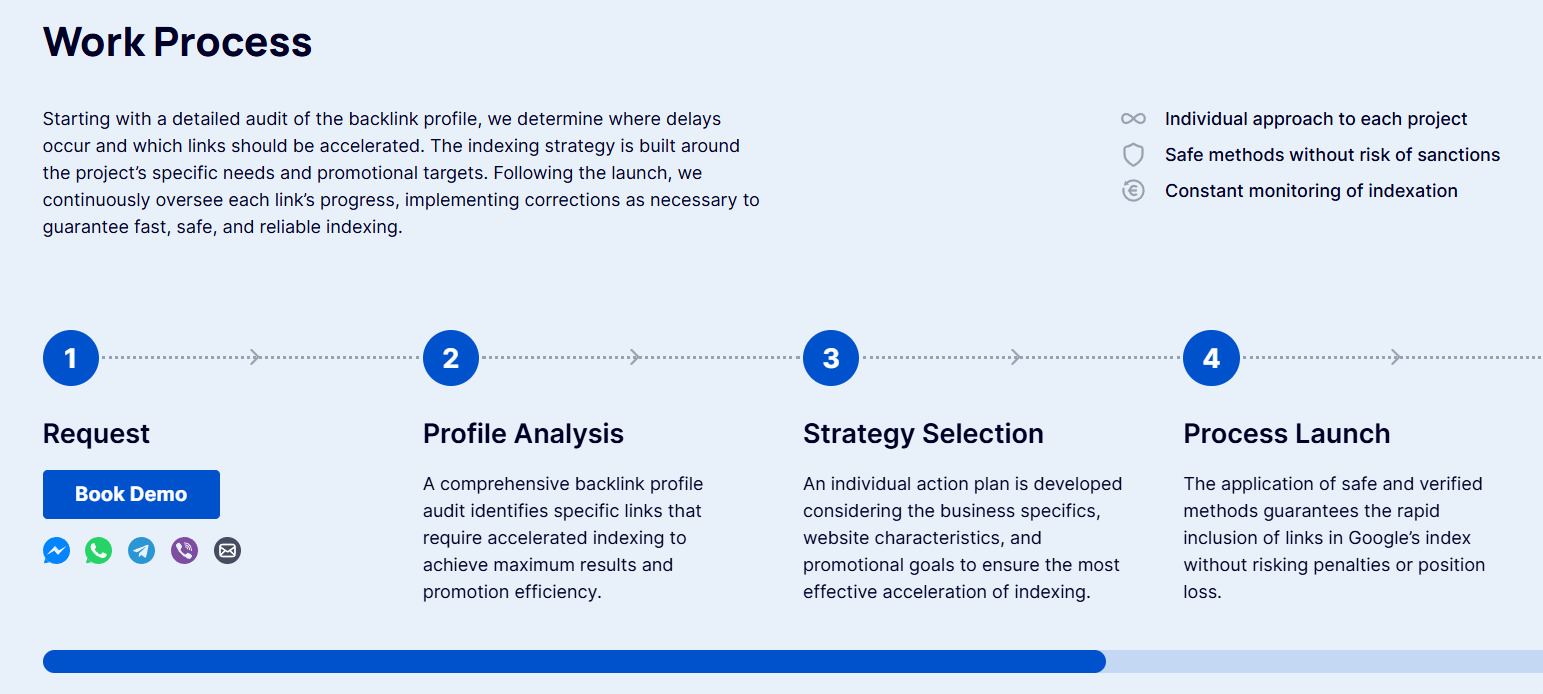
LinkBuilder.com offers an all-in-one approach to fast backlink indexing, combining multiple effective methods.
Advantages:
- Multi-tiered indexing approach
- Guaranteed results
- Over 90% link indexing rate
- Real-time monitoring
- Retries for problematic links
- Scalability
- Handles single links to large campaigns
- Tailored strategies for different link types
- Adapts to Google algorithm changes
- Expert support
- Analyzes indexing issues
- Recommends link quality improvements
LinkBuilder.com combines technological innovation with deep algorithm expertise, making it ideal for serious backlink indexing efforts.
How to Check If Links Are Indexed
Regularly checking backlink indexing is essential for effective link building. Without it, you risk wasting resources on links that don’t work for SEO.
Manual Search with Operators
The simplest yet effective way to check backlink indexing is using Google’s search operators.
Manual methods:
- “Site:” operator. Enter the donor page’s URL with “site:” (e.g., site:example.com/page). If the page appears, it’s indexed. To check a specific link, use “site:donor-domain your-domain.”
- “Cache:” command. Enter “cache:” before the URL to view the cached version. If available, the page is indexed.
- Unique text search. Copy a unique text snippet near your link and search it in quotes. If the page appears, it’s indexed.
- Google Search Console. The “Links” report shows external links Google has detected and considers.
For example, to check if our contextual links page is indexed, enter “site:linkbuilder.com/contextual” in Google.
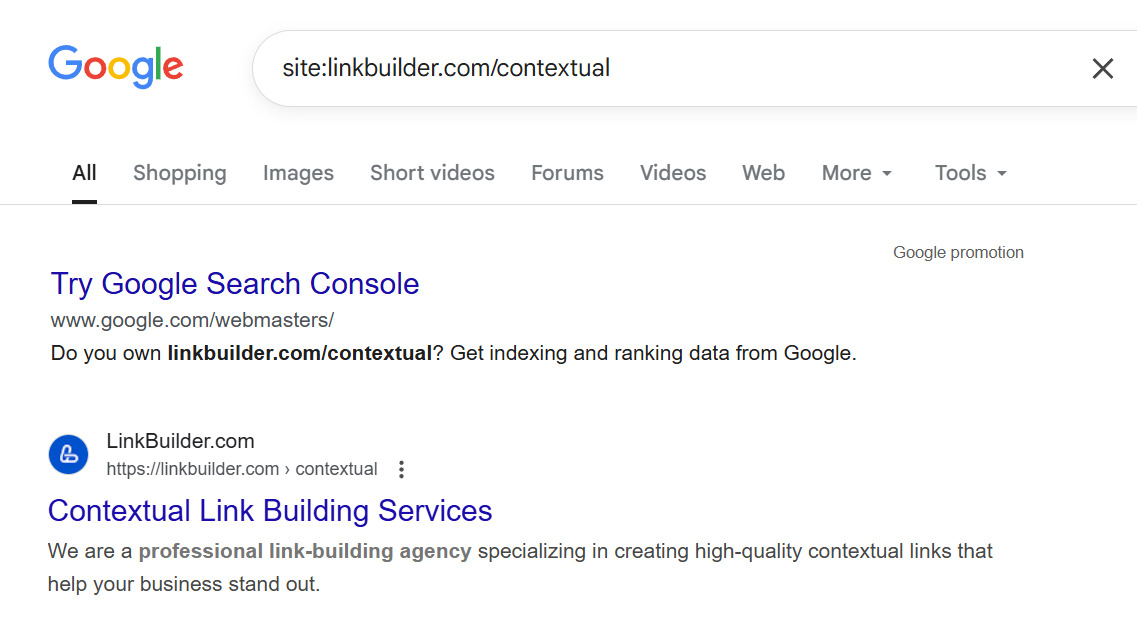
As expected, the page appears, confirming it’s indexed.
Limitations of manual checks:
- Time-consuming for many links
- Less accurate for new links
- Lacks detailed quality insights
Still, it’s an accessible way to investigate why backlinks aren’t showing up without paid tools.
Analysis with Ahrefs and Semrush
Automated tools for checking backlink indexing:
Ahrefs Site Audit: Tracks new and lost backlinks, including indexing status.
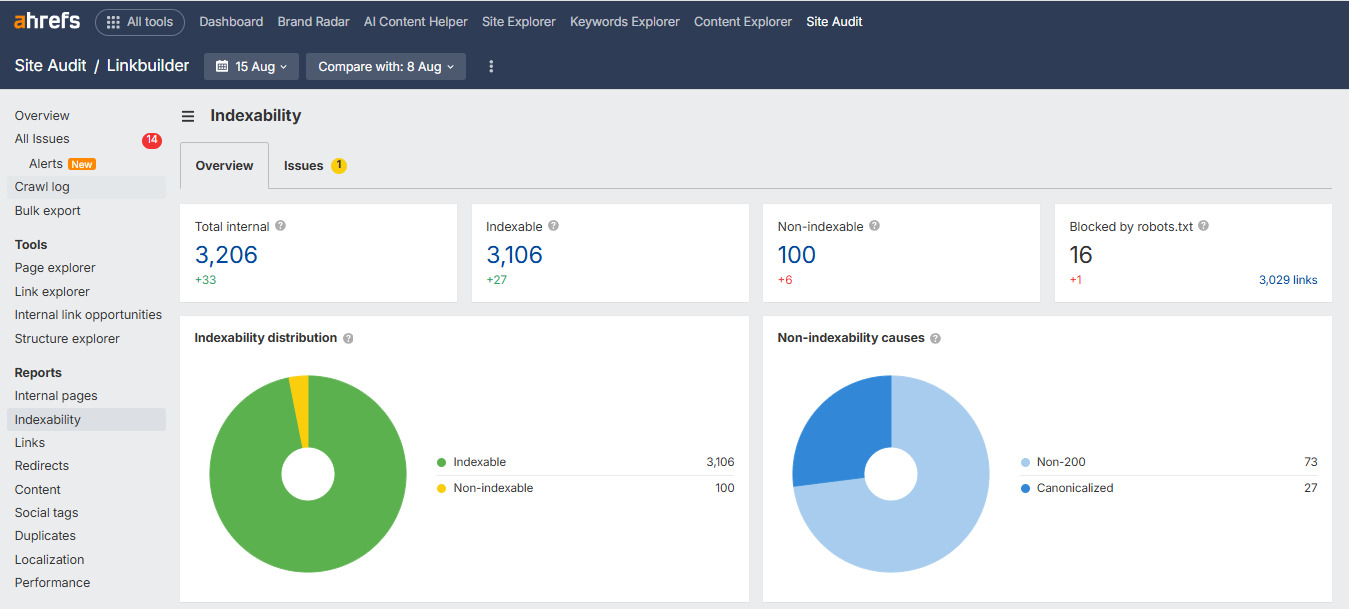
Semrush Site Audit: Shows crawlability/indexability and identifies common errors.
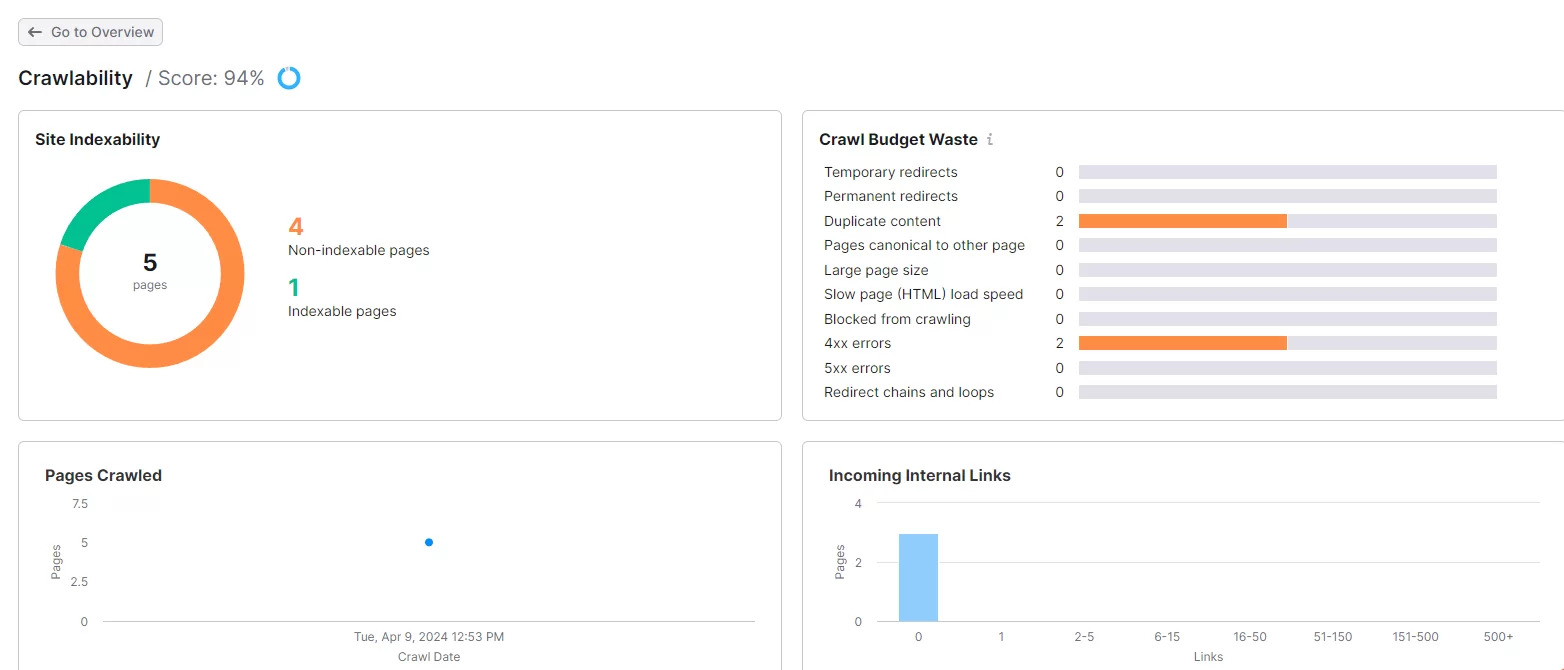
Monitoring services like Link Research Tools or Monitor Backlinks automatically track backlink status.
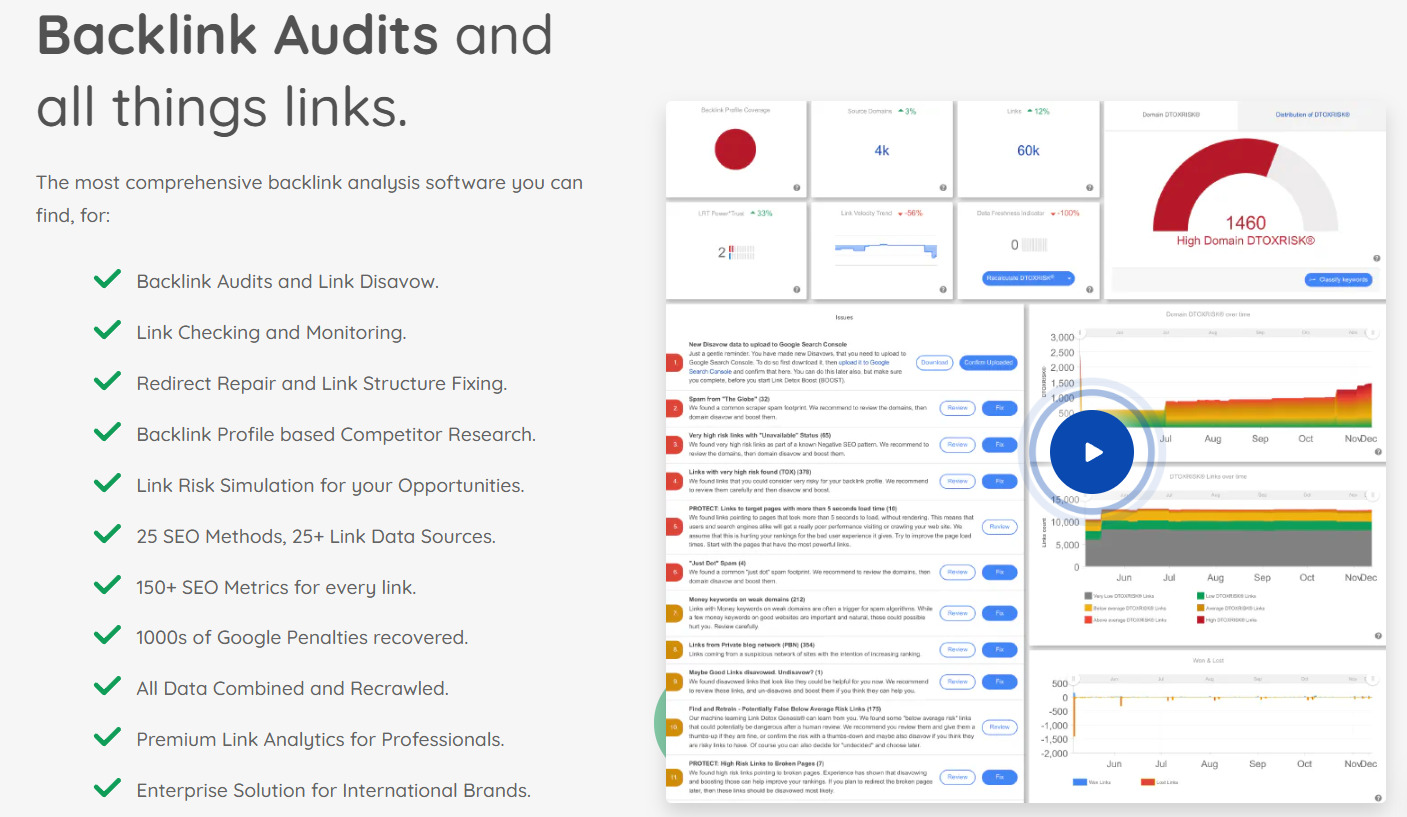
For accuracy, combine multiple tools, as each uses different databases and detection algorithms.
Tracking via Google Search Console
Google Search Console (GSC) provides direct access to Google’s data on your site, including external links.
Viewing inbound links:
- Log into GSC
- Select “Links” from the left menu
- Review:
- “External Links”: Sites linking to you
- “Top Linked Pages”: Your pages receiving links
- “Top Linking Text”: Common anchor texts
Checking indexing with URL Inspection:
- Select “URL Inspection” in GSC
- Enter the URL of the page with your link
- Review the indexing report
GSC limitations:
- Shows only significant links per Google
- Data updates may lag by weeks
- Can’t check specific links, only domains/pages
- No historical data
Despite limitations, GSC is the most authoritative source, as it uses Google’s data.
Combining methods provides a comprehensive view and faster issue resolution for backlinks indexing.
Common Indexing Mistakes and How to Avoid Them

Spammy Anchors
In 2025, Google’s algorithms are highly sensitive to unnatural anchors, using advanced text and context analysis.
Problematic anchors:
- “Buy cheap iPhone 15”
- “Best Nike sneakers discounts”
- “SEO services Prague prices”
Such commercial, exact-match anchors are often flagged as manipulative.
How to avoid:
Use diverse anchor types:
- Branded: Company name
- Topical: “Learn more about SEO,” “article on promotion”
- URL: “linkbuilder.com,” “this site”
- Generic: “here,” “click here,” “read more”
Anchors should blend naturally into the text and align with the context. Algorithms assess both the anchor and its relevance to surrounding content.
Ignoring Temporal Factors
Google’s crawl frequency varies by site and page. How long do backlinks take to work depends on multiple factors, including timing.
Indexing in 2025:
- Google reduced crawling for low-activity sites
- Priority goes to pages with regular updates
- Crawl intervals range from hours to months
How to avoid:
Place links on active pages with frequent content updates. Consider crawl budget – Google allocates limited time per site, prioritizing key pages.
Use services that mimic user visits to attract crawlers. Plan bulk indexing around non-holiday periods, as Google often updates algorithms during holidays.
Create a “path” to your links via indexed pages to speed up discovery.
Lack of Strategy Diversification
Relying on a single indexing method reduces effectiveness. Google is better at detecting manipulation through repetitive tactics.
Common mistakes:
- Using only pings or social signals
- Bulk-submitting URLs via Indexing API
- Over-reliance on backlink indexer tools without other methods
How to avoid:
Combine methods: APIs, social signals, internal links, and organic traffic. Use tiered indexing strategies.
Vary indexing pace for naturalness. Tailor methods to link type and importance. Conduct A/B testing to find effective combinations.
Diverse methods boost indexing rates and appear more natural to search engines.
Low-Quality Donors
Links on low-reputation, low-traffic, or technically problematic sites have lower indexing chances.
How to avoid:
Check donor indexing history. Assess technical metrics: loading speed, mobile optimization. Analyze organic traffic and search visibility.
Avoid sites with algorithmic penalty signs. Prioritize donors with active content plans and regular updates.
Lack of Systematic Monitoring
Without regular monitoring, you can’t catch indexing issues early or adjust strategies.
How to avoid:
Implement a system to track all key links. Set up alerts for issues. Create a dashboard with key metrics.
Analyze indexing speed trends and patterns. Document successful and failed cases to refine future strategies.
Where to Order Accelerated Google Indexing?

When DIY methods fall short or time is limited, professional services are the answer.
LinkBuilder.com – Professional Backlink Indexing Solution
LinkBuilder.com offers a comprehensive service specializing in fast, reliable backlinks indexing using cutting-edge techniques.
Why choose LinkBuilder.com:
- Proven proprietary method. Tested on thousands of links, using only safe, long-term-effective techniques.
- Personalized approach. Our experts tailor promotion methods to your business and brand needs.
- Manual acceleration, no spam scripts. We monitor each link’s status and adjust as needed.
- Transparent reporting. Access a client dashboard to track the entire process.
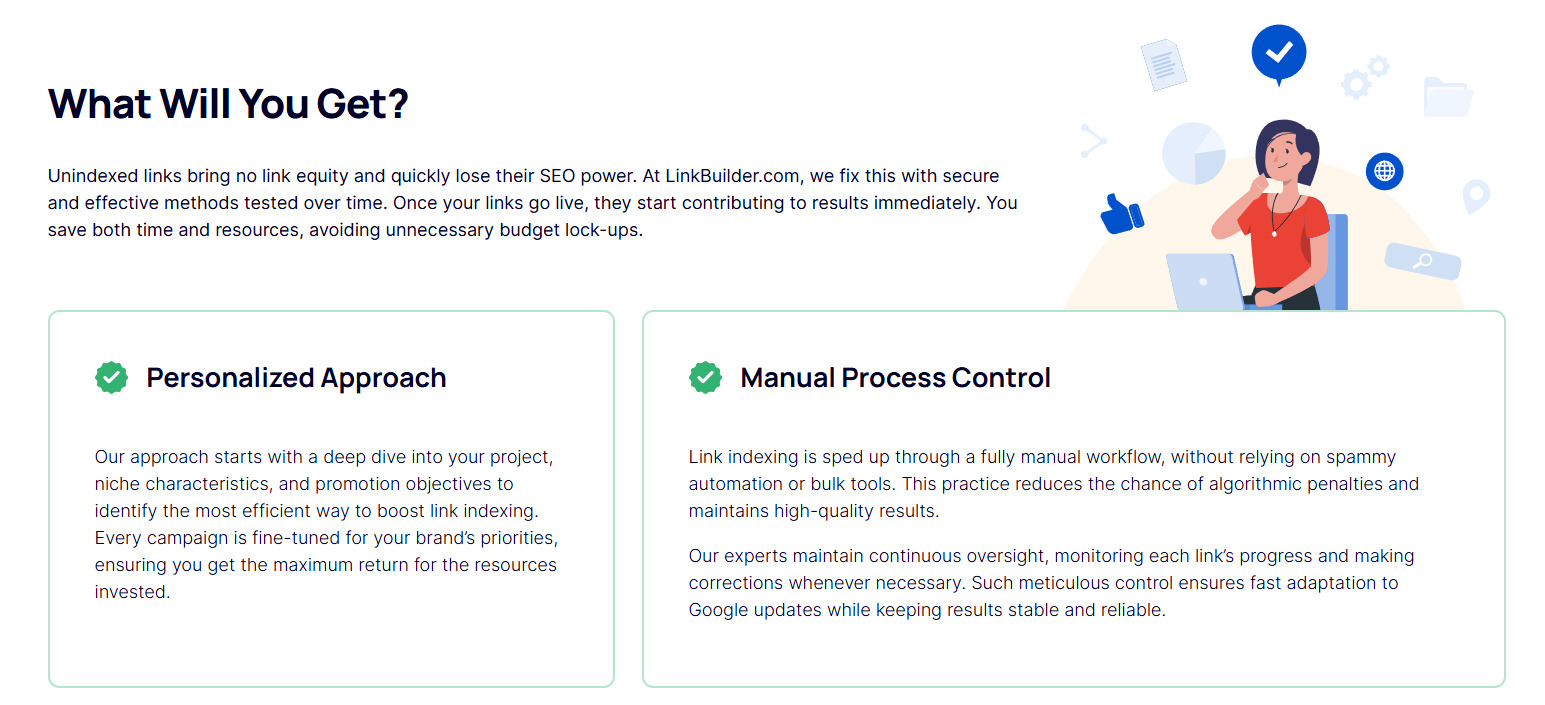
LinkBuilder.com process:
- Consultation and Audit
- Analysis of your current link profile
- Evaluation of existing links’ quality and indexing potential
- Development of an optimal strategy
- Indexing Plan Development
- Setting priorities and timelines
- Selecting methods for specific link types
- Setting up monitoring systems
- Strategy Execution
- Launching a multi-tiered indexing process
- Daily progress monitoring
- Tactical adjustments as needed
- Reporting and Analytics
- Regular reports on results
- Analysis of method effectiveness
- Recommendations for further optimization
Who benefits from LinkBuilder.com:
- SEO agencies managing multiple clients
- Site owners in competitive niches
- E-commerce sites needing quick link-building results
- Sites post-redesign or migration requiring link reindexing
- Companies launching urgent marketing campaigns
Choosing LinkBuilder.com for fast backlink indexing ensures a proven, professional solution. Request a demo to develop an indexing strategy for your project.
